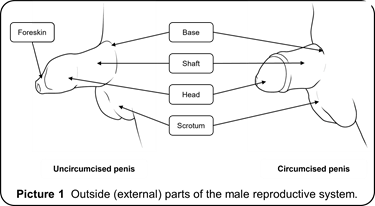Male Reproductive System
The male reproductive system is made up of parts inside (internal) and outside the body (external). It makes hormones and sperm when puberty starts.
Parts Outside the Body
Picture 1 (below) shows male reproductive parts outside the body (external). This includes:
- Penis– The organ where pee and semen (ejaculation fluid) leave the body. It is made of 3 parts.
- The base is where the penis attaches to the belly (abdomen).
- The shaft is between the base and head of the penis. After puberty, it becomes hard and rigid (erect) when you’re sexually excited.
- The head (glans) is the tip of the penis. There is foreskin covering the head of the penis. Sometimes the foreskin is removed during a circumcision.
- Scrotum – A loose sac of skin that holds the testicles. It hangs under the penis.
- Testicles (testes) – Oval-shaped organs in the scrotum. The body usually has 2 testicles that make the hormone testosterone and sperm cells. Sometimes, you can be born with only 1 testicle.

Parts Inside the Body
Picture 2 (below) shows male reproductive parts inside the body (internal) This includes:
- Epididymis – A long, coiled tube on the back of each testicle. It carries and stores sperm made by the testicles.
- Urethra – The hollow tube that carries pee and semen out of the body.
- Vas deferens (sperm duct) – A long, tube-like muscle that carries sperm from the epididymis to the urethra. There are 2 in the body – one for each testicle.
- Seminal vesicles – Sac-like pouches attached to the vas deferens. They make most of the semen.
- Ejaculatory duct – Carries fluid from the vas deferens and seminal vesicles to the urethra for semen to leave the body.
- Prostate gland – A small gland below the bladder. It adds more fluid to semen before it goes to the urethra. The urethra runs through the middle of the prostate gland.

Helping Hands™ Patient Education Materials
Helping Hands™ are easy-to-read guides about different illnesses, therapies, surgeries, and more. They’re created by the Patient Education team at Nationwide Children’s Hospital and are reviewed and approved by clinical staff, like nurses, doctors, pharmacists, and psychologists. Nationwide Children's Hospital is not responsible for misuse of information in patient education materials, including Helping Hands.
HH-IV-52 | ©1980, revised 2025, Nationwide Children’s Hospital
